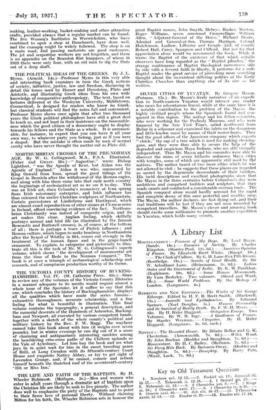NORTHUMBRIAN CROSSES OF THE PRE-NORMAN AGE. By W. G. Collingwood,
M.A., F.S.A. Illustrated. (Faber and GWyer. 30s.)—" Augustine," wrote Bishop Lightfoot, " was the Apostle of Kent, but Aidan was the Apostle of England." Aidan it was who, summoned by King Oswald from Iona, spread the good tidings of the Gospel in Bernicia after the withdrawal of the Roman eagles, and along with him there came into that rude north country the beginnings of ecclesiastical art as we see it to-day. This was an Irish art, since Columba's monastery at Iona sprang from Irish missionary enterprise, and Irish influence has thus coloured the earlier Christian sculptures of Northumbria. Certain gravestones at Lindisfarne and Hartlepool, which are almost exact reproductions of other stonesnt Clonmacnoise in Ireland, afford convincing evidence of the fact. Northum- brian Christianity was indeed of composite origin, and its art makes this clear. Anglian feeling, which skilfully portrays animal and bird life (as illustrated by the fainous Bewcastle and Ruthwell crosses), is, of course, at the bottom of all ; there is perhaps a trace of Pictish influence ; and Roman culture, which began to make headway in Northumbria after the Synod of Whitby in 664, comes out strongly in the treatment of the human figure and in the grape-bunch ornament. To explain, to categorize and pictorially to illus- trate all this is the task of Mr. %y. G. Collingwood's superb volume, which shows " the development of monumental art from the time of Bede to the Norman Conquest." The book is at once a triumph of archaeological scholarship and research, and of sumptuous production worthy of its theme.






















































 Previous page
Previous page